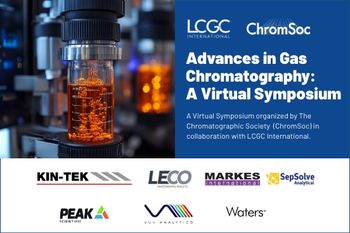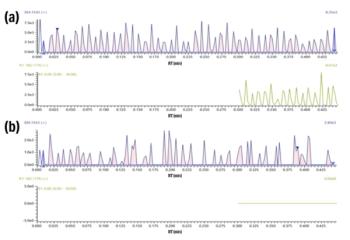
- The Column-04-09-2019
- Volume 15
- Issue 4
The Role of Chromatography in Entomotoxicology
The detection of drugs or other toxic substances can be crucial to forensic investigations. However, if the investigation involves a heavily decomposed, skeletonized, or missing corpse, that information can be difficult to obtain, and may require the skills of a unique branch of forensic toxicology-entomotoxicology. To explain the role of chromatography in this field, The Column spoke to Paola A. Magni from Murdoch University, in Perth, Australia.
The detection of drugs or other toxic substances can be crucial to forensic investigations. However, if the investigation involves a heavily decomposed, skeletonized, or missing corpse, that information can be difficult to obtain, and may require the skills of a unique branch of forensic toxicology-entomotoxicology. To explain the role of chromatography in this field, The Column spoke to Paola A. Magni from Murdoch University, in Perth, Australia.
Q. What is entomotoxicology and why is it important?
A: Entomotoxicology is a branch of forensic entomology that studies the detection of drugs or other toxic substances from insects developing on the decomposing tissues of a human corpse or animal carcass. Entomotoxicology also investigates the effects of these substances on insect development, survival, and morphology to provide an estimation of the minimum time since death.
The main idea is that “you are what you eat”, and it’s the same for insects that feed on carcasses; they feed on the flesh, but if the flesh is mixed with drugs of different types, the insects will consume it and there will be consequences on their survival and metabolism. Carrion insects can also be used as an alternative source of toxicological information when the body is highly decomposed or skeletonized, or even when the body is not there.
Entomotoxicology can be extremely important for crime scene reconstruction and for identifying key pieces of the puzzle to help solve the crime.
Q. What are the main priorities for investigation in this field, and what kind of information can be obtained?
A: Insects present at the scene must be collected and preserved following the best practices in forensic entomology considering both morphology studies and entomotoxicology, which are toxicological analyses. Failing these, the results of the analyses may be false positives or false negatives that can affect the overall investigation.
In the best-case scenario, entomotoxicological studies allow the identification of two main things: the presence of drugs that are associated with the body and could be the cause of death or simply part of the criminal story, and also correcting factors to be applied to typical growth tables of carrion insects. Growth tables allow us to backtrack the presence of the insects on the body, and therefore the time since death. Drugs may affect such tables, speeding up or slowing down the growth rates. Entomotoxicological research on different drugs and insect species allows the estimation of time since death in any circumstances.
Q. What kind of insects would you expect to collect during a field investigation and do insect species require different analytical procedures?
A: In theory, a forensic entomologist should not be biased with regards to the kind of insects that could be found at the scene and which will have a role in the investigation. However, the majority of the time we collect species of carrion blowflies and carrion beetles. Having said that, in one case I investigated a few years ago, a firefly had been the key to solving the case (1).
As per entomotoxicological analyses, the analytical procedure is similar because we target the insect cuticle made in chitin, which is similar to keratin in hair, and every insect has this cuticle. However, there are differences in the preparation of the sample when the insect is in an immature stage of life (the larva or maggot of a fly and pupa) or when it’s an adult (fly or beetle) or just the remains of it (fly puparia or beetle skins and faeces). In the case of immature insects, the fat content of the insect is more than the chitin content and it can affect the analyses if not prepared correctly. In our studies we either freeze or lyophilize the immature specimens prior to the analyses.
Q. What role does chromatography play in entomotoxicology?
A: The role of chromatography is pivotal in entomotoxicological analyses-as it is in general in toxicology. At present, there is a limited amount of research in this field; many of these use obsolete and unvalidated methods, and only a small number of insects.
Q. You recently developed a high performance liquid chromatography tandem mass spectrometry (HPLC–MS/MS) method for the detection of ketamine in Calliphora vomitoria (2). What were the results of this study?
A: In our study, larvae of the common blue bottle blowfly, Calliphora vomitoria, were reared on liver substrates homogeneously spiked with ketamine concentrations consistent with those found in humans after recreational use (300â¯ng/mg), or allegedly indicated as capable of causing death in either humans or animals (600â¯ng/mg). The results demonstrated a few things. First, our HPLC–MS/MS method is applicable to ketamine detection in C. vomitoria immatures, but not adults. The presence of ketamine at either concentration in the food substrate significantly delays the developmental time to complete the fly’s life cycle. The survival of C. vomitoria is negatively affected by the presence of ketamine in the substrate. Finally, the length and width of larvae and pupae exposed to either ketamine concentration were significantly larger than the control samples.
Q. What kind of sample preparation techniques are you using for your analysis?
A: Two samples-one sample consisting of 30 individuals and another sample split into three 1 g amounts-from each treatment were collected when C. vomitoria reached the second (L2), third (L3), post-feeding (PF), pupal (P), and adult (A) instars. Empty puparia (EP) were also collected.
Each sample of 30 individuals was used
for morphological analyses. Each of the three samples weighing 1 g from each of the instars was stored at -20 °C until the sampling period finished and then they were analyzed to detect ketamine. Larvae of L2 and L3 instars were sacrificed and stored only after careful cleaning of each individual with water and neutral soap to remove any external contamination. Adults were not provided with any food or water source and were sacrificed two days after their emergence.
Q. In a previous study in 2016 you developed a gas chromatography (GC)–MS method for nicotine detection (3). Are there any benefits to using HPLC over GC in entomotoxicology?
A: The choice is mainly based on which instrument is available. Nowadays, the costs for the two instruments are pretty similar. Only mass analyzers with very high resolution used in liquid chromatography are still very expensive.
Overall, the choice must be made by considering the sensitivity of the instrument for the specific molecule that is the focus of the analysis.
Q. Are there a lot of variables to consider when developing a method for this type of research, such as decomposition time and the multiple species of necrophagous insects? How do these parameters affect method development?
A: Not in this type of research. We try to keep things simple when we analyze the effects of the drugs for the first time.
With regards to the decomposition, we use insects from what is known to be the “first wave of decomposition”, that is, the first period after death, when the body is fresh. This means that we always begin our studies with fresh meat.
Q. Would it be possible to develop a universal method capable of analyzing for multiple chemicals of interest in corpses regardless of decomposition time?
A: The direction of our research is to have a single method able to prepare the sample for subsequent analyses on instruments that allows us to determine more than 100 analytes on a single chromatography run.
Q. What are you currently working on?
A: We are working on the effects of metals and pharmaceutical drugs that have been recently used for homicide purposes around the world. The aim is to provide information to solve real and actual cases.
In the case of ketamine, this is a medication mainly used for starting and maintaining anaesthesia. In recent years, ketamine has also been used as a recreational drug, and occasionally as a sedating drug to facilitate sexual assault. In both activities, it has resulted in several deaths. Furthermore, ketamine has been also implicated in the suspicious deaths of animals (2,4,5).
References
- R. Fico and P. Magni, Fireflies (Lampyris nocticula L., Coleoptera: Lampyridae) an adventive forensic insect (European Association for Forensic Entomology [EAFE] 2009).
- P.A. Magni, M. Pazzi, J. Droghi, M. Vincenti, and I.R. Dadour, J. Forensic Legal Med.3(58), 64–71 (2018).
- P.A. Magni, M. Pazzi, M. Vincenti, E. Alladio, M. Brandimarte, and I. Dadour, Forensic Sci. Int.261, 53–60 (2016).
- B.R. Lalonde and H.R. Wallage, J. Anal. Toxicol.28(1), 71–74 (2004).
- M.J. Derelanko and M.A. Hollinger, Handbook of Toxicology (CRC Press, Boca Raton, Florida, USA, 1995).
Paola A. Magni is a forensic biologist at Murdoch University, in Perth, Australia. Her research focuses include the application of natural sciences (entomology, taphonomy, and aquatic biology) to crime scene investigation. She has several years of experience as a researcher and lecturer in forensic science, and is regularly called upon to provide expert forensic witness for investigations, with many of these cases going on to be published in peerâreviewed publications. She has an ongoing collaboration with Marco Pazzi and Marco Vincenti at the Department of Chemistry at the University of Turin, in Turin, Italy, to conduct research in the field of entomotoxicology. She is the developer of “SmartInsectsÑForensic Entomology” (2013), a smartphone app designed to facilitate the work of law enforcement agencies and pathologists at crime scenes. She has also been a consultant and forensic expert with many television and radio shows including the Italian version of the TV series CSI: Crime Scene Investigation (RIS Delitti Imperfetti) where she provides stories and scientific advice for the production.
To learn more about Paola’s research, view her TEDxFremantle talk here:
You can also watch her interview on The Weekly with Charlie Pickering:
E-mail:
Articles in this issue
over 6 years ago
Vol 15 No 4 The Column April 2019 Europe & Asia PDFover 6 years ago
Vol 15 No 4 The Column April 2019 North American PDFover 6 years ago
House of Lords Calls on UK Government to Secure Science Fundingover 6 years ago
Shimadzu Employees Plant Many Treesover 6 years ago
Restek and LECO Expand Collaborationover 6 years ago
The Rise of the RobotsNewsletter
Join the global community of analytical scientists who trust LCGC for insights on the latest techniques, trends, and expert solutions in chromatography.




